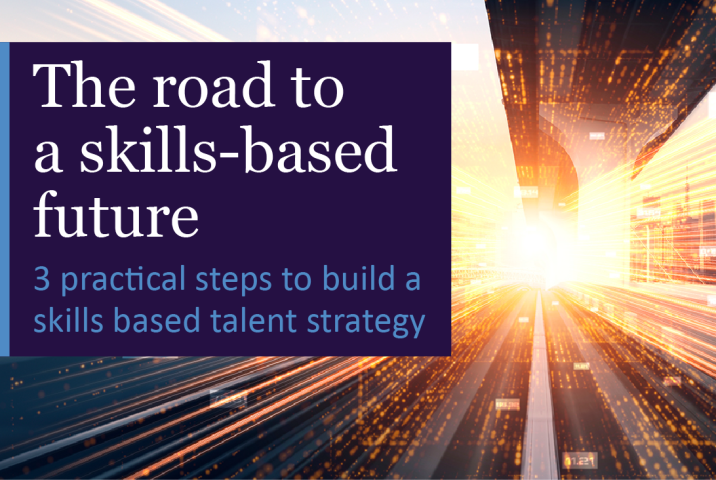The COVID-19 crisis has led to abrupt and seismic changes to how we work. As we move into a new post-pandemic climate, what have we learned – and how could and should those lessons inform talent acquisition in future?
Once upon a time, the talent acquisition (TA) community was busy getting to grips with the new world of digital that was unfolding before its very eyes. It was a time of huge disruption and change, from the rise of AI-based recruitment to fundamental labour-market changes, such as the shift to contingent and freelance working. Add in evolving workforce expectations, a host of new business models and a tricky digital skills gap, and it’s not hard to see why the community was beginning to wonder just how it was going to attract, acquire and deploy the kinds of skills needed to underpin this new world of work.
And then came 2020. With the COVID-19 global pandemic shutting down so much so abruptly, even challenge and change on the scale to which we’d become accustomed might seem like an age of innocence. Necessity, we have learned, is very much the mother of invention. Doing business remotely has become our reality rather than an aspiration. Organisations staffed with leaders sceptical about flexible working (and who had never even heard of Zoom) have had to adjust overnight. Just getting on that plane to fly across the Atlantic for a meeting no longer seems like a no- brainer. And TA teams experimenting with digital recruitment practices have had to shift online in short order.
Eventually, the pandemic will pass. Perhaps the more interesting questions to ask now are not about how things have shifted in response to the crisis, important though that is. Rather, we need to look ahead to a post-COVID world. Has the crisis changed the way we recruit and work forever? What will stick and what will be quietly sidelined as we start to open our offices? Is our new digital reality here to stay, and what will that look like?
TA teams are already asking themselves these very questions. According to research conducted at the peak of the pandemic by Aptitude on behalf of Alexander Mann Solutions, recruiting the right skills from the highest- quality candidates remains the priority, pandemic or no pandemic.
Unsurprising perhaps, but it’s also clear that, as the economic impact of COVID-19 bites hard, TA teams are going to have get even smarter to compete, whether that’s in terms of strategic workforce planning or the practicalities of attraction, hiring and onboarding. And all the while, staying on top of the competitive market for those essential digital skills.
The combination of digitisation and extraordinary circumstances has created the prospect for real, long-term change. Chris Bleakley, director of resourcing, Nationwide
There’s plenty of evidence, though, that crisis brings opportunity as well as challenge. In the wake of the 2007-8 financial crisis, a team of researchers from Harvard Business School and the Kellogg School of Management looked at the strategies and performance of some top US companies in response to previous economic recessions. They describe the companies that weathered the storms best as “progressive”, able to “deploy the optimal combination of defence and offence”. So, while our natural tendency might be to retrench, smart organisations balance the need for efficiency or cost-cutting with continuing to build for the future. Is this a model, we ask, for TA in a post-COVID world?
Remote, but not forgotten
Perhaps the most obvious and immediate impact of the pandemic has been the seismic shift to remote and homeworking. Even the most future-facing organisations could not have predicted the mass experiment in flexible working occasioned by COVID-19. But it’s clear that organisations that were already positioning themselves for more flexible ways of working have been at an advantage when it came to what might have been a difficult transition.
It’s not only the tech giants like Twitter – quick to blog about being “uniquely positioned to respond quickly and allow folks to work from home” – which deserve plaudits for what has been an extraordinary shift in working practices.
Michael Fiddaman, talent acquisition lead at Royal London, believes that already having in place a robust flexible working policy was a distinct advantage; within six days, 98% of the company was working remotely. It’s a very good example of how the crisis has accelerated wider business change processes that were already underway. “We’ve all bought into the need to operate as a sustainable, forward-facing, agile business, facilitated by the right tools and processes. And here we are, walking the walk.”
It’s a story replicated across all sizes and types of organisations. Nicky Hancock, managing director – Americas region for Alexander Mann Solutions, is quick to applaud companies which have proven that remote and flexible working really can work, even in the most unlikely context. “Who would have thought that we’d see investment bankers trading remotely – and successfully,” she says. “It may have been a change forced on us, but, in many fields of work, we have, somehow, found a way.
It remains to be seen, of course, whether this poster child of the pandemic will endure longer term. Hancock makes the point that it’s all very well when everyone has no choice but to adapt and is “in the same boat”. Things might look very different when offices start to re-open and the pressure to return to business as usual might become overwhelming.
For many TA teams, and the people for whom they’re responsible, however, there’s a real sense that COVID-19 has presented us with the opportunity to capitalise on much-needed change when it comes to often entrenched attitudes towards flexible working. It seems that, through necessity, we have proven a point, creating a baseline and blueprint for flexible workplaces and practices that are attractive for employers and employees alike.
Lasting change is about building on the behavioural change we’ve witnessed, according to Chris Bleakley, director of resourcing at Nationwide: “The level of empathy and trust we’ve seen from leaders has been a key element of successful COVID-19 remote working,” he says. “A focus on discretionary effort – cutting employees some slack when it comes to their personal contexts, managing childcare, looking after themselves – has led to happy, trusted and productive employees.”
The crisis has accelerated a shift away from more transactional job advertising to values- based storytelling. Michael Fiddaman, talent acquisition lead, Royal London
Of Nationwide’s 18,000-strong workforce, 12,000 members of staff have been working remotely during the crisis and productivity has gone up, not down. He points out that “changes like having contact-centre staff working from home might have taken years to achieve – if ever – under normal circumstances. The combination of digitisation and extraordinary circumstances has created the prospect for real, long-term change.”
Most importantly, it seems to be a change embraced by the majority. Nationwide’s sentiment-tracking surveys show that 87% of the workforce has welcomed the opportunity to work more flexibly. Would people like to be back in the office one-to-two days a week? Yes, please; we’d all really like to see our colleagues again. But five days? Perhaps not. Bleakley neatly sums up what many of us instinctively feel about the situation in which we find ourselves: “Post-COVID, social contact will still be important, but that doesn’t mean we all need to be in the office all the time.”
Putting the virtue into virtual recruitment
While the Aptitude survey data show that some companies have put recruitment on hold, for 62%, recruitment has continued. According to Laurie Padua, managing director at Alexander Mann Solutions’ Consulting Division, organisations have broadly fallen into two camps. The first has called a halt to recruitment for now, focusing instead on the wellbeing of existing staff and deploying them to support their ability to carry on operating.
In the other camp, firms have continued to recruit, in some sectors needing more people than ever. And that has meant, of course, the need to recruit without the face-to-face interaction usually associated with the average hiring decision. For Padua, it has “also thrown into relief the importance of the underpinning technology, whether that’s virtual interviewing, signing employment contracts digitally or remote onboarding.”
Of course, TA teams were busy digitising their operations long before the pandemic hit. Digital tools such as online recruitment portals or AI-driven candidate profiling are nothing new. What has been a change is carrying out the whole recruitment process remotely – with all that implies. Alexander Mann Solutions has even developed virtual careers events for new graduates, as well as virtual internship programmes, an initiative also positive for encouraging a more diverse range of participants.
The biggest single operational change for many has been the move to video-based assessment. For some hiring managers, this has been a steep learning curve, from getting to grips with the technology to trusting their hiring decisions without the familiar cues provided by being in the same room as candidates. At Royal London, hiring managers have often buddied up with their peers to support each other as they navigate this new world. It has also highlighted crucial emotional intelligence capabilities such as adaptability, self-management and empathy.
Despite the challenges, it seems that the virtual assessment genie is well and truly out of the bottle, with many organisations already looking forward to its post-COVID use, sometimes mandated, often in hybrid form, alongside traditional face-to-face interviews. Padua strikes one note of caution, though, predicting that, in a post-pandemic shake down, organisations may want to build on the progress made using commercially available video-conferencing software by replacing it with more bespoke, security-assured tech to ensure long-term sustainability.
It’s also thrown into relief the importance of the underpinning tech, whether that’s virtual interviewing, signing employment contracts digitally or remote onboarding. Laurie Padua, managing director, Alexander Mann Solutions’ Consulting Division
While it’s all systems go for virtual assessment, another aspect of remote recruitment seems to have proved more troublesome: onboarding. This is a perfect example of the balance we’re going to need to strike in future, deploying technology where it’s proven to have worked so well in a crisis, while accepting that, in an ideal world, there are some things that still need good old-fashioned human interaction.
Brand has also loomed large. The crisis has accelerated a shift already underway in terms of messaging; what Fiddaman calls “a ‘humanising’, a moving away from more transactional job advertising to values-based storytelling”. The pandemic has provided an opportunity to restate the organisation’s core values in response to the crisis and how they’ve adapted. Candidate feedback has been “encouraging”.
Nationwide is also highlighting its brand story. “Early on, we decided that no redundancies would take effect this year. Add to that our trusted, socially responsible brand, and being able to offer more flexibility, and that’s a very strong employee value proposition,” says Bleakley.
Strategic workforce planning triumphant
We can all rehearse the arguments around the need for flexible workforce planning, whether that’s leveraging the skills offered by a contingent workforce, recruiting for skills rather than job roles or making the maximum use of the skills already available to us. But we also know that more traditional organisational structures and priorities have not always been conducive to flexibility.
It seems, though, that this is another area where the pandemic might have acted as a catalyst. Alexander Mann Solutions’ Hancock has noticed that, where external hiring has either stopped or slowed down, this has sometimes meant more focus on developing and re-deploying skills internally. “Just take the example of one of our clients, a major American bank,” she says. “It committed to no lay-offs this year early on in the crisis, but it has also re-deployed and mobilised 3,000 of its employees to support areas within the business with high demand. We’ve been talking about skills not roles forever – and here’s an example of it in action.”
With the economic effects of the pandemic likely to be felt for some time, this optimisation of skills deployment may become a crucial factor as organisations look to agility as a way to weather the economic storm. It’s not without its challenges – the need to identify skills, people’s motivations and also sell it as a positive – but coronavirus is, once again, showing what can be done when the chips are down.
Organisations will certainly need to muster all the flexibility they can to attract those elusive digital skills. This is an area of the market where demand remains high and competition fierce. Facilitating homeworking and online recruitment is merely the tip of the iceberg when it comes to how digitisation has supported many a business through lockdown, accelerating, yet again, company-wide digital transformation. The dynamic is about nothing less than how to upskill and reskill workforces to deliver completely new ways of doing business.
When it comes to those skills, though, Claudio Fernández-Aráoz, writing in Harvard Business Review, reminds us again that economic crisis can provide opportunity as well as challenge. With downsizing a reality, as companies revisit their global strategies and as individuals recalculate their personal priorities around work, “the pool of available talent is suddenly both changing and expanding”. Just as a fledgling Hewlett Packard took advantage of de-mobbed US military engineers in the post-war world of the 1940s, successful post-COVID organisations will need to leverage every ounce of vision and agility to resist the temptation to retrench completely. Strategic investment in skills will be a crucial factor in sustainability.
For Fernández-Aráoz, this long-term thinking involves determined and targeted efforts, not only to source the best external candidates, but to retain and develop skills in-house. “This is also the time to carefully review your existing key players, stay closer to them than ever, assess their skills and knowledge,” he says.
TA teams are only too aware that this kind of strategic workforce planning is crucial for the talent challenges companies are bound to face. For Hancock, talent is talent, no matter where it comes from, and regardless of type of contract or working arrangements: “Organisations which come out of this crisis using and building on what they’ve learned will have a real competitive advantage in the market. The reality of the skills gap is still there. They’ve got to be creative about how and where they can attract people and what the deal will be in our new normal.”
Bleakley wants Nationwide’s learnings around flexible working to help it widen the net, both geographically, and by considering people who may not want to be office-based 9-to-5-ers, but still have the talent required. As an example, he cites the ‘outside-the-box’ thinking already adopted for Nationwide’s new internal IT team, selecting a city-centre location optimised for attracting the right people and anticipating a more drop-in, collaborative style of office design as a physical manifestation of a more nimble working practice.
The barriers are down, but only for a limited time. TA needs to press home this advantage right now. Nicky Hancock, managing director, Alexander Mann Solutions Americas
Towards a new future?
The words that come up most often when talking about how the coronavirus crisis has affected TA are ‘catalyst’ and ‘acceleration’.
Technologies and new ways of working have already changed forever the world of work, the jobs available and the skills needed to do them. Global management consulting firm McKinsey & Company has been tracking these trends closely and, like others, believes the pandemic has only made the need to address the skills gap more urgent. As workers navigate this new world, employers must learn how to match these workers to new roles and activities. It’s a challenge that’s going to need talent strategies that develop “employees’ critical digital and cognitive capabilities, their social and emotional skills, and their adaptability and resilience”, all capabilities that have more than proven their worth during the pandemic.
For the McKinsey team, this is not time for holding back; rather, it’s a time for companies to “double down on their learning budgets and commit to reskilling”, both to weather the immediate storm and to build resilience for future disruption: “Companies can’t be resilient if their workforces aren’t. Building your reskilling muscle now is the first step to ensuring that your organisation’s recovery business model is a success.”
It’s a call to arms not lost on the TA community. TA teams, already on a digitisation journey, want to use the adaptability and innovation we’ve seen in recent months as a springboard for more lasting change.
As the world of work anticipates the future, organisations everywhere are engaging in business-wide reviews of what a post-pandemic world might mean for their markets, their businesses and the skills they need. Padua believes that the crisis has led to a “fundamental shift in attitudes” that has accelerated thinking and initiatives already underway – and created a time of true opportunity for talent acquisition. Hancock agrees: “The barriers are down, but only for a limited time. TA needs to press home this advantage right now.”
Perhaps the last word might go to Bleakley, who wants to guard against “knee-jerk battlefield decisions” that might undo so much of the good he’s seen during the crisis: “The real change that has happened as a result of COVID-19 might have come from a negative place; the trick now is to flip that into more positive practice for the future.”
Originally published in Catalyst Magazine The 'Digital' Issue 5.

















